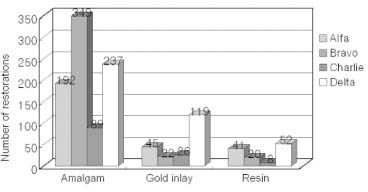References
1. Hickel R, Manhart J. Longevity of restorations in posterior teeth and reasons for failure. J Adhes Dent 2001. 3(1)45–64.
2. Mjör IA. The reasons for replacement and the age of failed restorations in general dental practice. Acta Odontol Scand 1997. 5558–63.
3. Roulet JF. Benefits and disadvantages of tooth coloured alternatives to amalgam. J Dent 1997. 25459–473.
4. Hickel R, Dasch W, Janda R, Tyas M, Anusavice K. New direct restorative materials. Int Dent J 1998. 483–16.
5. Palotie U, Vehkalahti M. Reasons for replacement and the age of failed restorations in posterior teeth of young Finnish adults. Acta Odontol Scand 2002. 60(6)325–329.
6. Anderson MH. Current concepts of dental caries and its prevention. Oper Dent 2001. 6(1)11–18.
7. Mjor IA. Amalgam and composite resin restorations: longevity and reasons for replacement 1989. Quintessence Publishing Co Inc; 61–80.
8. Allander L, Birkhed D, Bratthall D. Reasons for replacement of class II amalgam restorations in private practice. Swed Dent J 1990. 14179–184.
9. Forss H, Widstrom E. Factors influencing the selection of restorative materials in dental care in Finland. J Dent 1996. 24257–262.
10. Burke FJ, Cheung SW, Mjör IA, Wilson NH. Restoration longevity and analysis of reasons for the placement and replacement of restorations provided by vocational dental practitioners and their trainers in the United Kingdom. Quintessence Int 1999. 30234–242.
11. Mjör IA, Moorhead JE, Dahl JE. Selection of restorative materials in permanent teeth in general dental practice. Acta Odontol Scand 1999. 57(5)257–262.
12. Deligeorgi V, Mjor IA, Wilson NH. An overview of reasons for the placement and replacement of restorations. Prim Dent Care 2001. 8(1)5–11.
13. Burke FJ, Wilson NH, Cheung SW, Mjor IA. Influence of patient factors on age of restorations at failure and reasons for their placement and replacement. J Dent 2001. 29(5)317–324.
14. Letzel H, van't Hof MA, Marshall GW, Marshall SJ. The influence of the amalgam alloy on the survival of amalgam restorations: a secondary analysis of multiple controlled clinical trials. J Dent Res 1997. 761787–1798.
15. Mjör IA. Long term cost of restorative therapy using different materials. Scand J Dent Res 1992. 10060–65.
16. Stoll R, Sieweke M, Pieper K, Stachniss V, Schulte A. Longevity of cast gold inlays and partial crowns-a retrospective study at a dental school clinic. Clin Oral Investig 1999. 3100–104.
17. Ryge G. Clinical criteria. Int Dent J 1980. 30(4)347–358.
18. Ryge G. In : Anusavice KJ, ed. The Californian dental association quality evaluation system: a standard for self-assessment. Quality Evaluation of Dental restorations 1989. Chicago: Quintessence Pub Co Inc; 273–286.
19. Ryge G, Jendresen MD, Glantz PO, Mjor I. Standardization of clinical investigators for studies of restorative materials. Swed Dent J 1981. 5(5-6)235–239.
20. Mjör IA, Moorhead JE, Dahl JE. Reasons for replacement of restorations in permanent teeth in general dental practice. Int Dent J 2000. 50(6)361–366.
21. Gruythuysen RJ, Kreulen CM, Tobi H, van Amerongen E, Akerboom HB. 15-year evaluation of Class II amalgam restorations. Community Dent Oral Epidemiol 1996. 24207–210.
22. Mjör IA, Dahl JE, Moorhead JE. Placement and replacement of restorations in primary teeth. Acta Odontol Scand 2002. 60(1)25–28.
23. Smales RJ, Webster DA, Leppard PI. Survival predictions of amalgam restorations. J Dent 1991. 19272–277.
24. Plasmans PJ, Creugers NH, Mulder J. Long-term survival of extensive amalgam restorations. J Dent Res 1998. 77453–460.
25. Mjör IA, Shen C, Eliasson ST, Richter S. Placement and replacement of restorations in general dental practice in Iceland. Oper Dent 2002. 27(2)117–123.
26. Hamilton JC, Moffa JP, Ellison JA, Jenkins WA. Marginal fracture not a predictor of longevity for two dental amalgam alloys: a ten-year study. J Prosthet Dent 1983. 50200–202.
27. Osborne JW, Norman RD, Gale EN. A 14-year clinical assessment of 12 amalgam alloys. Quintessence Int 1991. 22857–864.
28. Christensen GJ. The coming demise of the cast gold restoration? J Am Dent Assoc 1996. 1271233–1236.
29. Wagner J, Hiller KA, Schmalz G. Long-term clinical performance and longevity of gold alloy vs ceramic partial crown. Clin Oral Investig 2003. 780–85.
30. Hayashi M, Wilson NH, Watts DC. Quality of marginal adaptation evaluation of posterior composites in clinical trials. J Dent Res 2003. 82(1)59–63.











